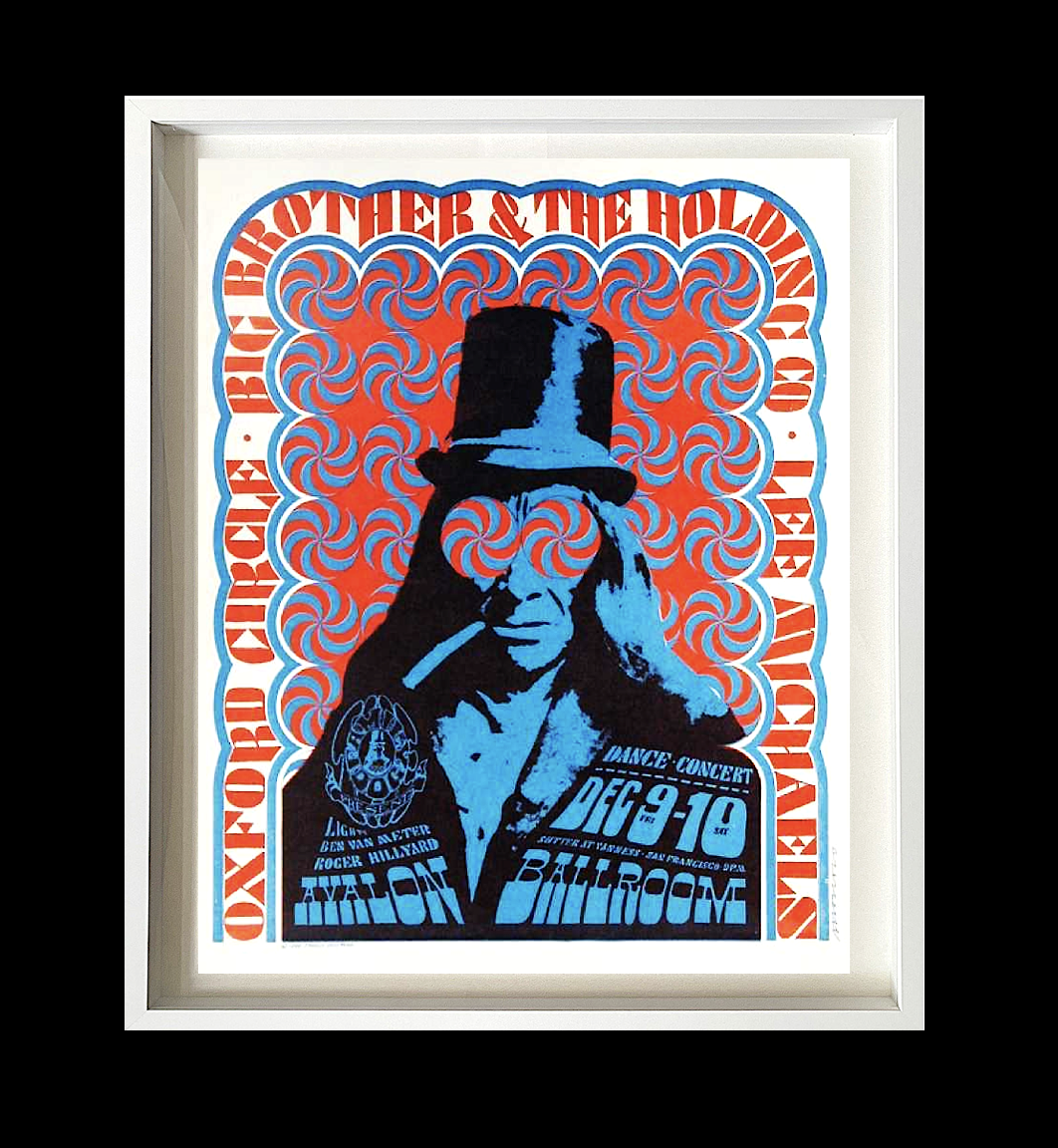

Title: Big Brother & The Holding Company Top Hat Psychedelic Art Poster
Shipping: $29.00
Artist: N/A
Period: 20th Century
History: N/A
Origin: N/A
Condition: Good
Item Date: 1966
Item ID: 5558
Big Brother and the Holding Company "Top Hat" Avalon Concert Poster Family Dog 1966 By Artist Victor Moscoso. This is a great art poster starring Janis Joplin and the Holding Company from December, '66, featuring the top-hatted Indian mascot of Chet Helm's Family Dog Productions. Joining Janis and the boys that night were Oxford Circle and keyboard whiz Lee Michaels. Victor Moscoso provided the tripped-out graphics. The post-concert 3rd printing measures 14" x 20 3/8" and deletes the Bindweed credit, adding instead " Family Dog Productions, 1725 Washington Street, San Francisco" to the lower right hand corner. "No. 38-3" is in the lower left hand corner. Big Brother & The Holding Company Concert PosterAvalon Ballroom concert held December 9-10th 1966 in San Francisco. Pre concert first printing. Bindweed Press. Family Dog Productions. Big Brother evolved out of the San Francisco music scene and was in the forefront of the psychedelic music movement. Janis Joplin joined the band in June of 1966. Measures 14 3/16” x 18” ht.
Link: http://en.wikipedia.org/wiki/Psychedelic_art
Psychedelic art is any kind of visual artwork inspired by psychedelic experiences induced by drugs such as LSD, mescaline, and psilocybin. The word "psychedelic" (coined by British psychologist Humphry Osmond) means "mind manifesting". By that definition all artistic efforts to depict the inner world of the psyche may be considered "psychedelic". In common parlance "Psychedelic Art" refers above all to the art movement of the late 1960s counterculture. Psychedelic visual arts were a counterpart to psychedelic rock music. Concert posters, album covers, lightshows, murals, comic books, underground newspapers and more reflected not only the kaleidoscopically swirling patterns of LSD hallucinations, but also revolutionary political, social and spiritual sentiments inspired by insights derived from these psychedelic states of consciousness.
Leading proponents of the 1960s Psychedelic Art movement were San Francisco poster artists such as: Rick Griffin, Victor Moscoso, Bonnie MacLean, Stanley Mouse & Alton Kelley, and Wes Wilson. Their Psychedelic Rock concert posters were inspired by Art Nouveau, Victoriana, Dada, and Pop Art. The "Fillmore Posters" were among the most notable of the time. Richly saturated colors in glaring contrast, elaborately ornate lettering, strongly symmetrical composition, collage elements, rubber-like distortions, and bizarre iconography are all hallmarks of the San Francisco psychedelic poster art style. The style flourished from about 1966 - 1972. Their work was immediately influential to album cover art, and indeed all of the aforementioned artists also created album covers.
Although San Francisco remained the hub of psychedelic art into the early 1970s, the style also developed internationally: British artist Bridget Riley became famous for her op-art paintings of psychedlic patterns creating optical illusions. Mati Klarwein created psychedelic masterpieces for Miles Davis' Jazz-Rock fusion albums, and also for Carlos Santana Latin Rock. Pink Floyd worked extensively with London based designers, Hipgnosis to create graphics to support the concepts in their albums. Los Angeles area artists such as John Van Hamersveld, Warren Dayton and Art Bevacqua and New York artists Peter Max and Milton Glaser all produced posters for concerts or social commentary (such as the anti-war movement) that were highly collected during this time. Life Magazine's cover and lead article for the September 1, 1967 issue at the height of the Summer of Love focused on the explosion of psychedelic art on posters and the artists as leaders in the hippie counterculture community.
Psychedelic light-shows were a new art-form developed for rock concerts. Using oil and dye in an emulsion that was set between large convex lenses upon overhead projectors the lightshow artists created bubbling liquid visuals that pulsed in rhythm to the music. This was mixed with slideshows and film loops to create an improvisational motion picture art form to give visual representation to the improvisational jams of the rock bands and create a completely "trippy" atmosphere for the audience. The Brotherhood of Light were responsible for many of the light-shows in San Francisco psychedelic rock concerts.
Out of the psychedelic counterculture also arose a new genre of comic books: underground comix. "Zap Comix" was among the original underground comics, and featured the work of Robert Crumb, S. Clay Wilson, Victor Moscoso, Rick Griffin, and Robert Williams among others. Underground Comix were ribald, intensely satirical, and seemed to pursue weirdness for the sake of weirdness. Gilbert Shelton created perhaps the most enduring of underground cartoon characters, "The Fabulous Furry Freak Brothers", whose drugged out exploits held a hilarious mirror up to the hippy lifestyle of the 1960s.
Psychedelic art was also applied to the LSD itself. LSD began to be put on blotter paper in the early 1970s and this gave rise to a specialized art form of decorating the blotter paper. Often the blotter paper was decorated with tiny insignia on each perforated square tab, but by the 1990s this had progressed to complete four color designs often involving an entire page of 900 or more tabs. Mark McCloud is a recognized authority on the history of LSD blotter art.